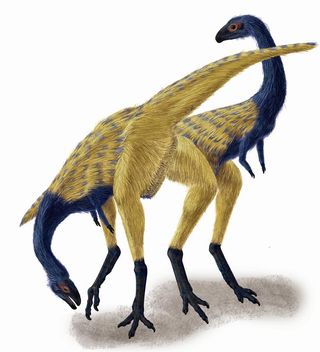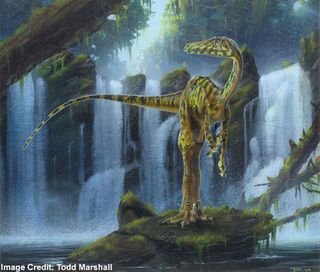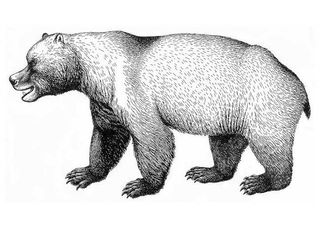Amazing Ancient Beasts
Airplane-Size Bird

Imagine a bird like an ocean-going goose almost the size of a small plane. That was this ancient, giant pseudo-toothed bird, or pelagornithid. It lived around what is now England 50 million years ago.
Hurdia Victoria

Reconstruction of Hurdia victoria, a 500-million-year-old monster-looking predator that was about 1.5 feet long.
Three-Fingered Dinosaur

The fossilized hands from this plant-eating dinosaur reveal a transitional step in the evolution of modern wings from dino digits. The finding could resolve a debate over which fingers ultimately became embedded in the wing. This dinosaur, Limusaurus inextricabilis, may have used its three-fingered hands to help it stand upright from a lying position. Its hand showed a vestigial first finger and robust second and third fingers.
Giganotosaurus

Giganotosaurus was 47 feet long and weighed 8 tons. It lived 95 million years ago. It was not the biggest carnivore ever, though. That credit goes ti Spinosaurus, thought to reach 55 feet in length.
Troodon

Troodon had one of the largest brain-to-body size ratios of any known dinosaur and it is believed to have been one of the most intelligent dinosaurs that ever lived. Its large, slightly forward facing eyes suggest that it was a nocturnal creature with excellent depth perception and it had long arms that it could fold back like a bird. It lived about 70 million years ago.
Darwinopterus

The remains of this flying reptile, called Darwinopterus modularis, suggest the animals may have been an aerial predator, hunting small feathered dinosaurs (such as the one depicted here) and tiny gliding mammals some 160 million years ago.
European Cave Bears

European cave bears were the first of the mega-mammals to die out in the most recent historical round of big-time extinctions, going extinct around 13 millennia earlier than was previously thought, according to a new estimate. The new extinction date, 27,800 years ago, coincides with a period of significant climate change, known as the Last Glacial Maximum, when a marked cooling in temperature resulted in a reduction or total loss of the vegetation that the cave bears ate.
Sign up for the Live Science daily newsletter now
Get the world’s most fascinating discoveries delivered straight to your inbox.
Giant Ape

A gigantic ape standing 10 feet tall and weighing up to 1,200 pounds lived alongside humans for over a million years, researchers say. A fresh analysis of two previously found skulls determined they're 200,000 old, making them the oldest known examples of our species. Yet fossil records indicate musical instruments, drawings, needles and other sophisticated tools didn't appear until about 50,000 years ago, suggesting Homo sapiens had a pretty lowbrow culture for 150,000 years. Well, evolution takes time. Another team found the fossilized remains of what they think is humankind’s first walking ancestor, from 4 million years ago. Other research confirmed that the oldest human ancestor, from the time when we split with the apes, lived around 6 million years ago. Oh, and you have to respect our relatively recent ancestors (the lowbrow folks) who we now know lived among 10-foot-tall gorillas that have since gone extinct. Maybe they were so busy running they had no time to paint or create alphabets.
Woolly Rhino

The woolly rhinoceros grazed in the plains of what is now northern Thuringia in Germany. The climate at the time was icy cold and far drier than today, and fluctuated a great deal.
Indohyus

This ungulate Indohyus ranged in India 48 million years ago. Indohyus is a close relative of whales, and the structure of its bones and chemistry of its teeth indicate that it spent much time in water. In this reconstruction, it is seen diving in a stream, much like the modern African Mousedeer does when in danger.












